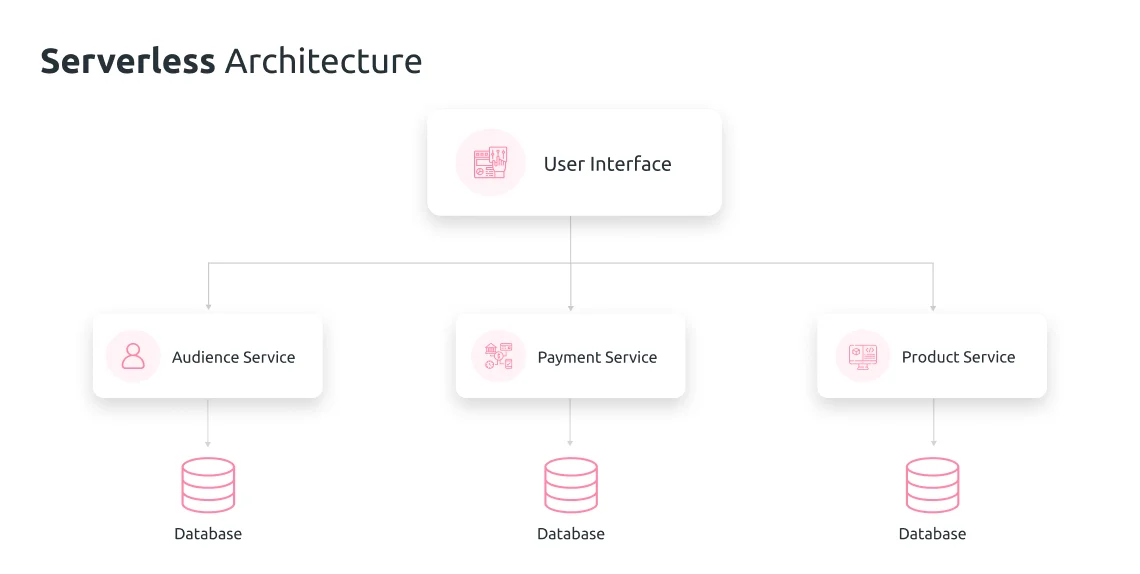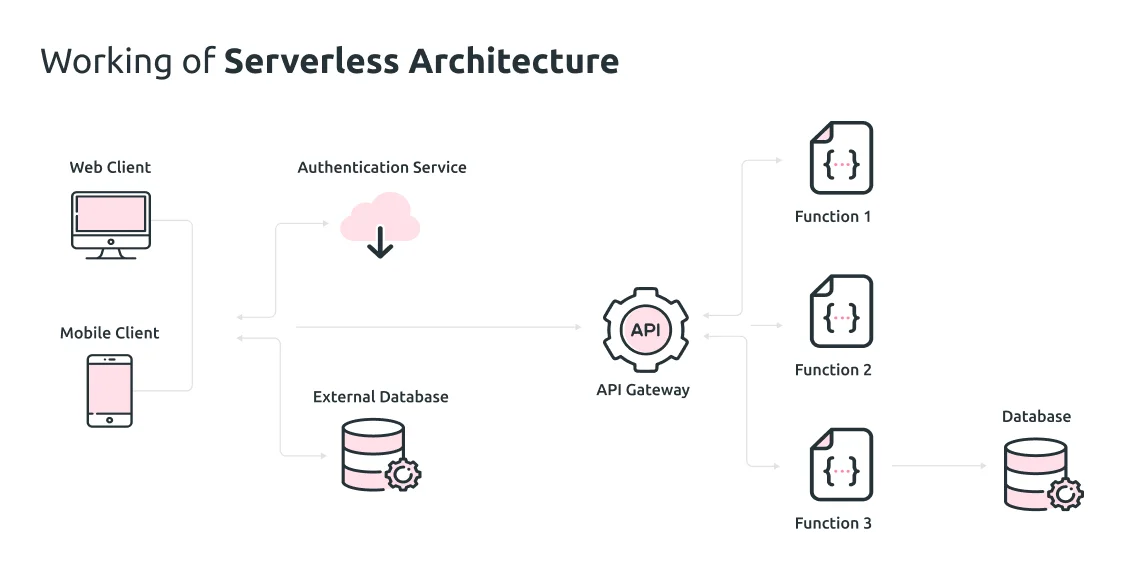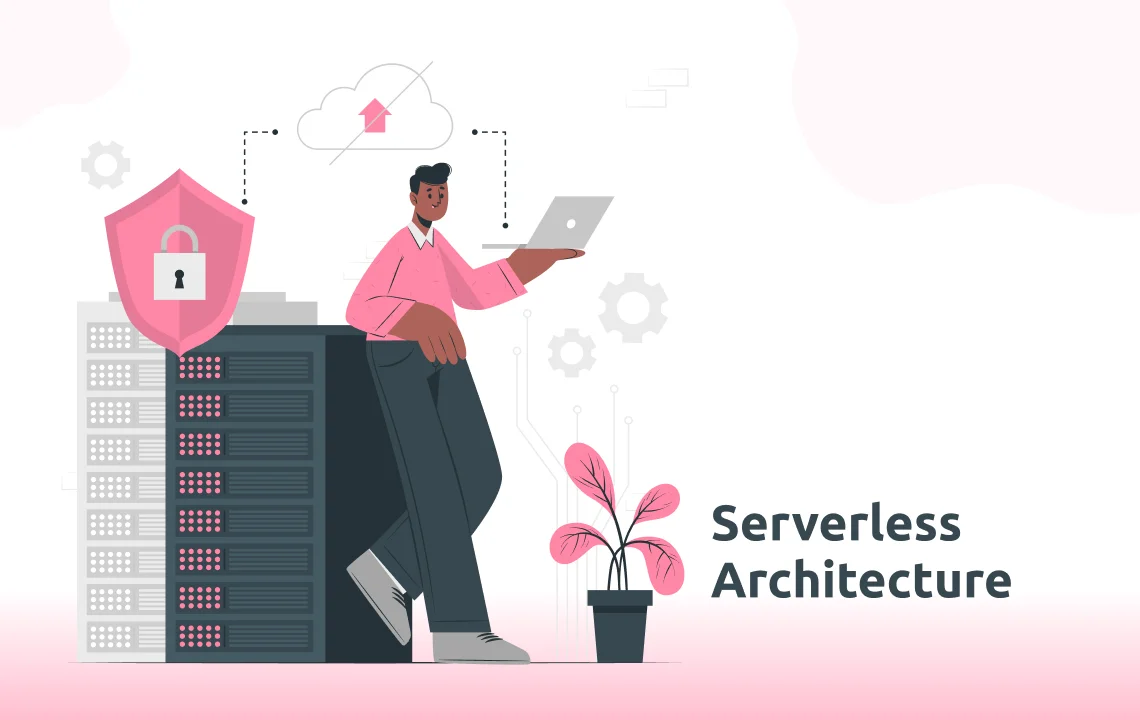Serverless Architecture for Cloud-based App Development: Top Benefits and Challenges
- DevOps
- July 13, 2022
Gone are the days when developers had to think much about servers during app development. They needed lots of strategies and budgets for purchasing or leasing, powering, powering, and placing these servers before having them set up in the data center. But then they got the concept of serverless architecture.
Serverless architecture is a highly demanding method for cloud-based app development, where you need to outsource the servers’ deployment and maintenance to third parties. Developers, who don’t want to maintain the basic infrastructure needed for testing, running, and distributing app code, generally go for the serverless architecture.
The serverless IT infrastructure will be maximized in the future. Hence, if you still haven’t explored this technology, you can soon plan to use it. Undoubtedly, this technology lowers functional complications, reduces expenses, and boosts DevOps efficacy.
According to Verified Market Research, the Global Serverless Architecture Market size is expected to reach $ 36.84 Billion by 2028, growing at a CAGR of 21.71% from 2021 to 2028.

A Brief Introduction to Serverless Architecture
When a third-party vendor offers the infrastructure as BaaS (Back-end as a Service), we call it serverless architecture. You must install an API to register for this cloud-based infrastructure and use the services offered. The payment mode of using this infrastructure is viable enough for any company or individual.

After writing the code, the developers submit it to the vendor for testing, debugging, deployment, and maintenance. And the vendor offers essential tools for all these mentioned tasks. Users choose a tool as per their requirements.
This cloud-based infrastructure is event-driven. Every event asks for a function done as FaaS (Function as a Service) to carry out all the important activities.
The Elements of a Serverless Architecture
The serverless architecture is not precisely serverless, as it includes some elements that are essential for working with third-party servers. The framework of this cloud-based architecture for app development should have these elements:
1. Security Token Service
Serverless users use the API offered by the third-party providers to log into the system and utilize its services. The infrastructure should produce a security token for users before they use the API.
2. Web Server
The web server needed to perform client apps should be potent enough to deal with all the static CSS, HTML, and JavaScript needed.
3. FaaS Solution
A FaaS (Function as a Service) solution is an essential component of the serverless infrastructure. It allows developers to create, run, deploy, and maintain apps without requiring a server infrastructure. A developer can use any tool, OS, or framework through FaaS with only a few clicks.
4. User Verification
In a standard serverless environment, clients usually register for the service. And then the serverless computing ensures every end-user can register and log into the application conveniently.
5. Client Software
The client interface should perform on the client-side, regardless of your server infrastructure’s condition. Hence, client apps can easily run on a web server.
6. Database
Whether an app is built and managed on a serverless infrastructure or not, its data must be stored in a database. In short, a strong database has become an essential part of this cloud-based infrastructure.
How Does The Serverless Application Work?
A serverless architecture is important for developers to perform certain functions. Hence, the model is usually provided as FaaS.

Here’s how those functions are written and applied in the serverless computing architecture:
- Developers write a function that usually meets a particular requirement within the application code.
- Then, developers describe an event that drives the cloud service provider to implement a function. Usually, they use HTTP requests as a basic event.
- The event gets started. If an HTTP request is the event, users can start it with a click.
- Next, the function gets implemented. The cloud provider makes sure whether the function’s instance is working. Otherwise, it begins another instance of the function.
- The users receive the results of their activities within the app.
The Benefits of Serverless Architecture
Serverless infrastructure provides several benefits over conventional cloud-based architectures. Developing a serverless web app means developers can concentrate on the main product and will not be concerned about managing or operating servers. Let’s discuss why serverless computing is beneficial for app development!
1. Quick Start
Serverless computing features BaaS building blocks for standard functions. Therefore, you get instant solutions for APIs, databases, file storage, etc. It helps you combine backend services with your application and immediately makes your system stable.
2. High Scalability
Serverless applications can scale up or down according to the number of users increasing or decreasing. When a function should run on several instances, the servers kickstart, run, and finish as and when required using containers.
Therefore, a serverless app can deal with many requests while processing even one smooth request from one or multiple users. For this reason, businesses prioritizing traffic like to use serverless computing for high scalability.
3. Improved Efficacy
Conventional servers must be running always. However, you should pay per request with serverless infrastructure while using the server. This boosts efficacy as there is no worry about setup, scaling, and capacity planning.
4. Low Operational Expenses
Human resources and infrastructure are two primary costs for any project. Serverless computing lowers the infrastructure expenses a lot. Since people focus more on software building solutions instead of maintaining the architecture, their productivity grows.
5. Improved Latency
The app’s response is an essential point that impacts an application’s performance. Latency is based on physical location and, using the worldwide access points, serverless apps can deal with global users. Therefore, serverless architecture enhances app response time and ensures worldwide coverage.
6. Instant Updates and Deployments
A serverless infrastructure doesn’t require you to upload code to the servers for backend configurations for launching an app version. Developers can easily upload codes and launch the new version.
Hence, the development doesn’t need to check whether the update has been rolled out across multiple devices. When you add a new technology or business feature, any client can use it in real-time.
7. Improved Operation Management
Legacy systems have provided the architecture for maximizing companies’ software. Since these systems repress innovation, dependency on them can be harmful for a business. By using serverless infrastructure, businesses should consider innovation since the providers deal with all the architectural requirements.
8. Enhanced Pivoting
Serverless computing makes execution and maintenance easier than on traditional servers. Many businesses think they have targeted the right audience or that their product has been perfectly developed.
Well, serverless infrastructure helps businesses innovate rapidly and experience quick results. Startups can pivot as an organization with more freedom and benefits.
Hindrances of Serverless Architecture
Everything is not okay with serverless computing infrastructure. It too has some drawbacks and challenges that you should fix, so they don’t grow further. These are a few of the challenges of serverless architecture:
1. Complexity
Creating a serverless architecture takes time and has some complexities. Determining every function’s size is essential while building a serverless app. For small functions, developers can grow into a massive combination of functions in the name of the app.
Development, testing, debugging, and monitoring are difficult to optimize in terms of bigger functions. Choosing tools for every step of solution creation is another challenge experienced by developers.
2. Security
Serverless infrastructures are distributed across public cloud environments. They have more surface area than conventional applications. Hence, check functions with more fair IAM policies, unauthorized requests, and outdated libraries.
3. Inadequacy of Operational Metrics and Tools
Many operations in a serverless app are tough to understand. Presently, the third party is not launching a sufficient number of operational metrics.
Hence, developers face challenges in debugging and monitoring apps. In terms of outages, they don’t have an adequate number of tools to control traffic or take essential measures to fix the issues.
4. Third-Party API Problems
While using serverless infrastructure, developers don’t control their own apps. And when end-users use these apps, the performance of third-party APIs may pose many challenges, like loss of functionality, forced updating, security, vendor control, etc.
Expenses may rise because many third-party service providers charge based on the number of functions running or the amount of time resources are used. If the vendor offers a shared architecture, security, speed, and bug fixes may become difficult.
5. Warm or Cold Startup Issues
It’s challenging to resolve the service speed in serverless functions. Functions that are left unused for a long time are known as “cold functions.” Functions that are in use currently are called “warm functions.” Cold functions take more time to release than warm ones.
Examples of Serverless Infrastructure
Here are some genres of serverless architecture that are in use in several industries:
1. IoT Backend
Handling IoT devices’ servers can be challenging if they are connected to tens of applications. Serverless infrastructure helps developers concentrate on making rules that kickstart database search for some devices, providing activation codes when devices ask for access, and device registration logic.
2. Web Application Architecture
In terms of building web application architecture, cloud providers allow you to develop the API and connect with the cloud services. This is as easy as signing into the account and running the codes.
Moreover, creating an SPA (single-page application) becomes simpler with serverless cloud computing. These pages can create an ideal case for going serverless due to their limited dependencies and lightweight features.
3. Mobile Application Backend
The best part of serverless cloud infrastructure is its capacity to provide multiple environments. Through this infrastructure, developers can create native applications’ backend. It makes rendering tasks easier when users ask for the cloud vendor’s serverless functions.
4. SaaS Software
SaaS software development helps deal with fluctuating service load in terms of clients and tasks. Resolving the ever-increasing market demand has been difficult for solution architects. And serverless infrastructure makes it easier due to automatic scaling up features that support rapid deployment and continuous innovation.
When Can You Use Serverless Architecture?
You can use a serverless architecture if:
- You want to lower development expenses without compromising on quality.
- Your applications have unnecessary server load.
- You wish to create effective solutions instead of keeping up with architecture.
- The applications are made to be constantly changed.
- You are seeking automatic scaling up without engaging in complications.
When Should You Not Use Serverless Architecture?
You must not use serverless infrastructure:
- If you seek a fast response from the server. Functions in a serverless cloud infrastructure usually go cold if left unused, requiring manual intervention.
- Because the FaaS functionality has a limited lifetime, real-time apps use WebSockets.
Why is Serverless Architecture the Future of Modern App Development?
Although the serverless architecture has many challenges, we can consider it the future of modern app development. After all, it allows low-cost app development, easy operation scalability, and less time to market.
Serverless architecture is still in its budding phase, being only five years old. It’s becoming popular due to its multiple benefits. However, it should be more transparent, secure, and robust for a wide range of uses. Organizations offering serverless cloud services should launch more operational tools and metrics and offer them to developers for easy debugging and maintenance.
How Can MindInventory Help Make Your Business Model Serverless?
At MindInventory, we help organizations worldwide develop their apps with serverless architecture. Here’s how we help companies build a serverless app:
- We understand clients’ needs.
- Then, we decide on a specific tech stack for the serverless application.
- Next, we offer an app-building strategy and confirm our estimates.
- We start building the system infrastructure and writing documentation.
- Ultimately, we arrange the environment for data storage. This is why we use Amazon Redshift or Amazon S3 Bucket data warehouse clusters. Also, we suggest exploring AWS Lambda on your app’s backend. For this matter, we create functions for your website and set them up.

Bottom Lines
Tech biggies are using serverless architecture these days. Every industry accepts this infrastructure. However, it still has some limitations. Also, the success of a framework or infrastructure is based on several factors, not only on technology.
Hence, the use of the right infrastructure according to clients’ needs is essential. We have experience in building enterprise applications with a serverless architecture. Get in touch with us to select a serverless architecture for modern app development.
FAQs on Serverless Architecture
Microservices is used to develop different types of applications by the help of container, while Serverless is an environment which is used to run an application. Microservices can be hosted on Serverless.
Many companies have started adopting serverless architecture, and they have reported increased productivity. A few of the companies are Netflix, Codepen, Nordstrom, Coca Cola, Zalora, etc.
Serverless does not mean that servers are no longer required. The term “serverless architecture” is used from the perspective of developers who do not have to maintain the underlying infrastructure necessary for the testing, running, and deployment of application code.













